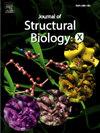Indel-driven evolution of the canavanine tRNA-editing deacetylase enzyme CtdA
IF 5.1
Q2 BIOCHEMISTRY & MOLECULAR BIOLOGY
引用次数: 0
Abstract
Proteins are heteropolymers composed of twenty standard amino acids, but over 500 non-proteogenic amino acids exist in nature that can be misincorporated into proteins. Canavanine is an antimetabolite of the chemically similar L-arginine. It can be utilized by bacteria such as Pseudomonas canavaninivorans in the legume rhizome as a sole source of carbon and nitrogen. However, canavanine misincorporates in proteins of this bacterium as its arginyl-tRNA synthetase loads tRNAArg with both canavanine and arginine. Canavanyl-tRNAArg deacetylase (CtdA) removes canavanine from misloaded tRNAArg, preventing its protein toxicity, being the first enzyme known to edit tRNA mischarged with a non-proteinogenic amino acid. We have elucidated CtdA’s crystal structure and studied its active site using site-directed mutagenesis. We found that CtdA is a small monomeric enzyme with a central, deep cavity that predictably is the canavanine binding site and a positively charged surface area that likely coordinates the CCA-3′ tRNA attachment sequence. CtdA is distantly related to the B3/B4 cis-editing domains of the multi-subunit enzyme Phenylalanine-tRNA-Synthetase (PheRS). CdtA and B3/B4 domains from bacterial and archaeal/eukaryotic origin are three subclasses of a conserved 3D-fold that differ in type-specific indels, which shape the substrate binding site. We propose a class-unifying nomenclature of secondary structure for this fold. In CtdA, residues Y104, N105, E118 and E191 are relevant for catalysis, of which N105 is conserved in bacterial B3/B4 domains. Residue N105 is in proximity of the canavanyl-ribose junction and might coordinate the nucleophilic water molecule that attacks the substrate, possibly sharing a mechanistic role in CtdA and bacterial B3/B4 editing enzymes.

indel驱动的牛磺酸trna编辑去乙酰化酶CtdA的进化
蛋白质是由20种标准氨基酸组成的异聚物,但在自然界中存在超过500种非蛋白质氨基酸,它们可以被错误地掺入蛋白质中。大麻氨酸是化学上相似的l -精氨酸的抗代谢物。它可以被豆科根茎中的细菌利用,如芥绿假单胞菌,作为碳和氮的唯一来源。然而,由于该细菌的精氨酸- trna合成酶同时将canavanine和arginine装载到tRNAArg中,因此canavanine在该细菌的蛋白质中会发生错配。Canavanyl-tRNAArg去乙酰化酶(CtdA)将Canavanyl-tRNAArg从负载错误的tRNAArg中去除,防止其蛋白质毒性,是已知的第一个编辑带有非蛋白质原性氨基酸的tRNA的酶。我们利用定点诱变技术阐明了CtdA的晶体结构并研究了其活性位点。我们发现CtdA是一种小的单体酶,其中心有一个深腔,可预测是canavanine结合位点,其表面带正电,可能协调CCA-3 ' tRNA附着序列。CtdA与多亚基酶Phenylalanine-tRNA-Synthetase (PheRS)的B3/B4顺式编辑域有远亲关系。来自细菌和古细菌/真核生物的CdtA和B3/B4结构域是保守3d折叠的三个亚类,它们在塑造底物结合位点的类型特异性索引上有所不同。我们提出了该褶皱二级结构的类统一命名法。在CtdA中,残基Y104、N105、E118和E191与催化作用有关,其中N105在细菌B3/B4结构域保守。残基N105位于canavananyl -核糖连接处附近,可能协调攻击底物的亲核水分子,可能在CtdA和细菌B3/B4编辑酶中共享机制作用。
本文章由计算机程序翻译,如有差异,请以英文原文为准。
求助全文
约1分钟内获得全文
求助全文
来源期刊

Journal of Structural Biology: X
Biochemistry, Genetics and Molecular Biology-Structural Biology
CiteScore
6.50
自引率
0.00%
发文量
20
审稿时长
62 days
 求助内容:
求助内容: 应助结果提醒方式:
应助结果提醒方式:


